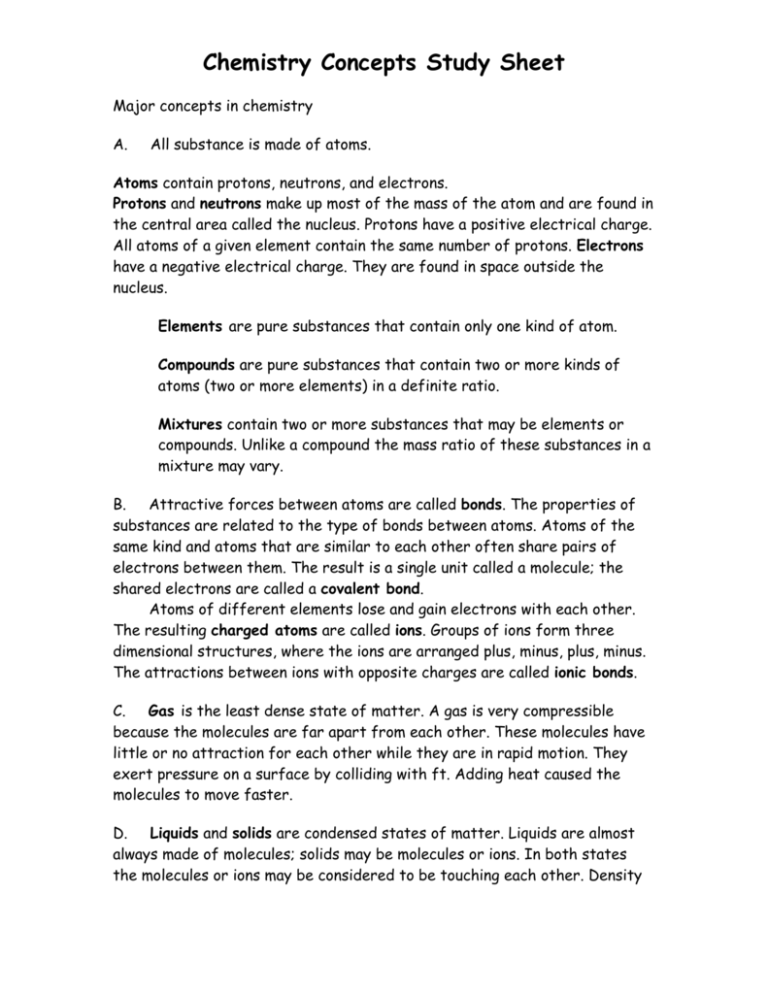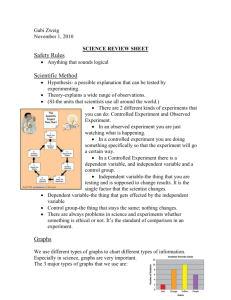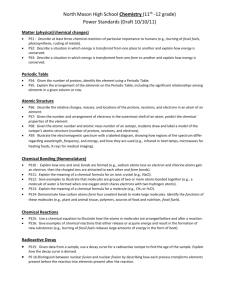CAPT Chemistry Concepts Study Sheet
advertisement

Chemistry Concepts Study Sheet Major concepts in chemistry A. All substance is made of atoms. Atoms contain protons, neutrons, and electrons. Protons and neutrons make up most of the mass of the atom and are found in the central area called the nucleus. Protons have a positive electrical charge. All atoms of a given element contain the same number of protons. Electrons have a negative electrical charge. They are found in space outside the nucleus. Elements are pure substances that contain only one kind of atom. Compounds are pure substances that contain two or more kinds of atoms (two or more elements) in a definite ratio. Mixtures contain two or more substances that may be elements or compounds. Unlike a compound the mass ratio of these substances in a mixture may vary. B. Attractive forces between atoms are called bonds. The properties of substances are related to the type of bonds between atoms. Atoms of the same kind and atoms that are similar to each other often share pairs of electrons between them. The result is a single unit called a molecule; the shared electrons are called a covalent bond. Atoms of different elements lose and gain electrons with each other. The resulting charged atoms are called ions. Groups of ions form three dimensional structures, where the ions are arranged plus, minus, plus, minus. The attractions between ions with opposite charges are called ionic bonds. C. Gas is the least dense state of matter. A gas is very compressible because the molecules are far apart from each other. These molecules have little or no attraction for each other while they are in rapid motion. They exert pressure on a surface by colliding with ft. Adding heat caused the molecules to move faster. D. Liquids and solids are condensed states of matter. Liquids are almost always made of molecules; solids may be molecules or ions. In both states the molecules or ions may be considered to be touching each other. Density of solid or liquid material is always much greater than density of gas where there is space between molecules. Adding heat energy to a solid, causes its particles to move faster, eventually the solid melts as the molecules can move past each other. If enough energy is added the molecules move so rapidly that they overcome all attraction between each other and fly independently (vaporize) into the gas phase. E. Solutions are homogeneous mixtures. Components of a solution are often called the solvent and the solute. Water is the most common solvent. Many reactions occur in water solution. Solutions may contain any state dissolved in any other state. Air is a solution of mainly nitrogen gas and oxygen gas with small amounts of other substances like water and carbon dioxide. The composition (or ratio of components) in a solution may vary, where a compound has only one definite ratio of components. F. Chemical Reactions occur when atoms change the way they are combined with each other. Atoms break apart from one another and form new combinations with other atoms. While new substances are formed the same atoms are still present and mass of the whole is preserved. Evidence of chemical reaction includes changes in heat, light, color, and gas formation. One important type of reactions occurs between acid and bases. Acids solutions are sour, cause indicators to change color (litmus is red in acid), and destroy the properties of bases. These behaviors are explained by Hydrogen ions, H1+, that are produced by the acid molecule. Bases taste bitter, cause litmus to turn blue, and destroy the properties of acid, all because of the hydroxide ions, OH1-. The pH scale is often used to measure the acid - base properties of a solution. pH 0 1 2 3 4 5 6 7 8 9 10 11 12 13 14 | strong acid weak acid neutral weak base strong base G. Rates of chemical reactions can be controlled by changing concentration, temperature, and using catalysts. LABORATORY TECHNIQUES AND EQUIPMENT Technique Discussion Example Dissolve to make a solution by mixing dissolve salt in water, a solute (solid, liquid or gas gas in a liquid, or gas in a with a solvent. gas, etc. Filtration to pout a liquid containing insoluble solid(s) through a piece of filter paper supported by a funnel remove a precipitate or other insoluble material from a liquid Decant after allowing solids to settle, pour off the liquid leaving the solid behind pour water from a beaker leaving sand behind. evaporation heat the liquid to its boiling Salt water is boiled, point allowing it to escape as leaving the original a gas leaving the solid amount of solid behind. behind distillation process in which the liquid is alcohol is distilled from heated and its vapors are the fermenting mixture condensed in a separate leaving water and container. impurities behind. EQUIPMENT Instrument Measurement Unit balance mass grams (g) graduated cylinder volume milliliters, (mL); cubic decimeters (dm3) buret volume milliliters, (mL); cubic decimeters (dm3) thermometer temperature barometer atmospheric pressure mm Hg, kPa, mm Hg meter stick length millimeters (mm), meters (m) spectroscope wavelength of light nanometers (nm) ºCelsius, Kelvin








